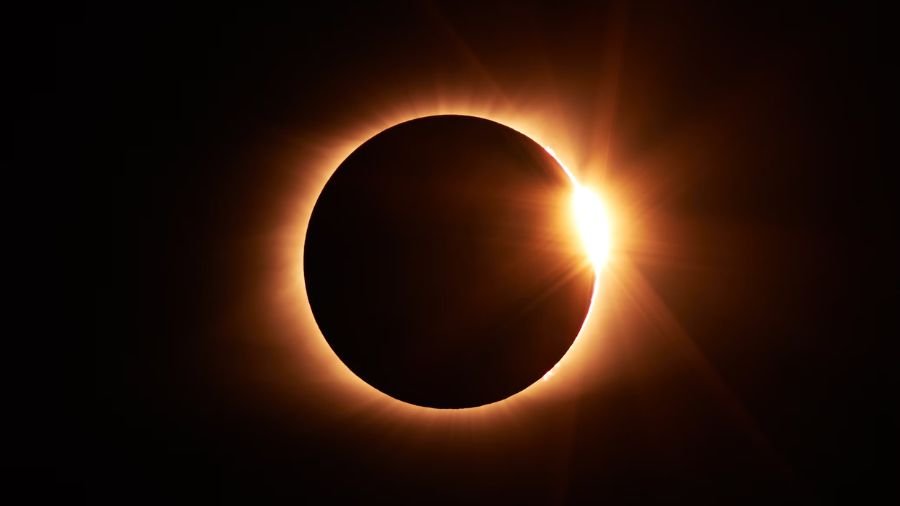Upcoming Astronomical Events in April 2024
Astronomical Events also known as celestial body events that occurs outer space. They can be anything such as eclipses, planetary collisions, meteor showers, and other such occurrences that happens outer the orbit of the earth. We have given detailed information on some of the astronomical events that is about to happen on April 2024.
Venus and Neptune conjunction on April 03 2024
The Venus and Neptune conjunction is going to happen on April 3, 2024, at 10:53 GMT (06:53 a.m. ET). During this time Venus will come closer to Neptune in the Pisces constellation. Venus, which is the brightest star, is easy to see, but Neptune could be dimmer and harder to spot.
The two planets will be super close which is only about 0.17 degrees apart. This makes it a special event for anyone interested in star gazing. If you want to see this wonderful conjunction, find a place with less light pollution and look to the east before sunrise.
You may need binoculars or a telescope to see Neptune, especially if you’re in a bright area. It’s best to start watching a bit before 10:53 GMT to catch the moment when Venus and Neptune are closest. You can Use a stargazing app or map to help you find where to look at the sky in the Pisces constellation.
Date: April 3, 2024
Event: Venus and Neptune conjunction
Total Solar Eclipse on April 08, 2024
A total solar eclipse, an infrequent astronomical occurrence, is poised to take place in April 2024. During this event, the moon will pass between the Earth and the sun, obscuring the sun’s disk and casting a shadow on certain regions of the Earth’s surface. This alignment results in a temporary darkening of the sky, known as totality, as observed from specific locations along the eclipse’s path.
The upcoming eclipse holds particular significance due to its rarity, transpiring approximately once every 126 years. Its path of totality is projected to traverse North America, stretching from Mexico through the United States and into Canada. Within this path, observers will witness the complete obscuration of the sun’s disk, experiencing a brief period of darkness during daylight hours.
Scientifically, the eclipse offers a unique opportunity for researchers to study various phenomena associated with the sun’s outer atmosphere, or corona. Total solar eclipses provide an exceptional circumstance to observe the corona’s structure, dynamics, and behavior, which are typically challenging to discern due to the sun’s intense brightness.
By analyzing the corona during totality, scientists can gain insights into solar activity, such as solar flares, coronal mass ejections, and solar winds, all of which have implications for space weather and its effects on Earth’s technological infrastructure.
Additionally, the eclipse serves as an educational tool, fostering interest and engagement in science among students and the general public. Witnessing such a rare cosmic event firsthand can inspire curiosity about astronomy, physics, and the natural world, potentially sparking lifelong pursuits in scientific inquiry.
Date: April 08, 2024
Event: Total Solar Eclipse

Lyrid meteor shower from April 16 to April 25
The Lyrid meteor shower is happening in 2024, and it’s going to be a cool sight to see. It’s called the Lyrid because the meteors appear to come from the constellation Hercules. These meteors are actually tiny pieces of debris left behind by a comet called C/1861 G1 (Thatcher). When Earth passes through this debris, the particles burn up in our atmosphere, creating bright streaks in the sky.
If you’re in Mountain View, California, you’ll be able to see the Lyrid meteor shower starting around 9 PM every night from April 16th to April 25th. The best time to see the most meteors will be around 5 AM. That’s when the meteors will be highest in the sky and easiest to spot.
Usually, the Lyrid meteor shower produces about 18 shooting stars per hour at its peak. But because the Moon will be pretty bright during this time, some of the fainter meteors might be hard to see. Still, if you find a dark spot away from city lights, you could spot up to 17 meteors per hour.
Remember, the key to seeing the most meteors is not to stare directly at the radiant point in Hercules, but to look about 30–40 degrees away. This way, you’ll catch more meteors streaking across the sky.
Date: April 16th to April 25th
Event: Lyrid meteor shower










